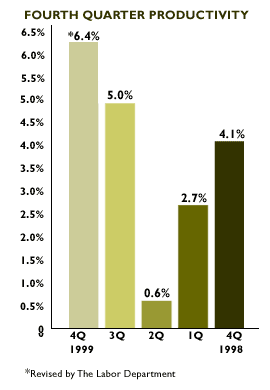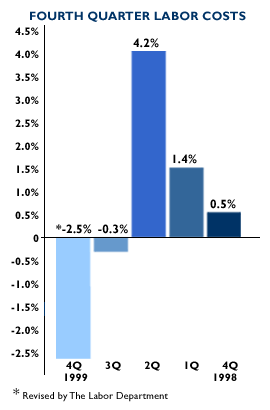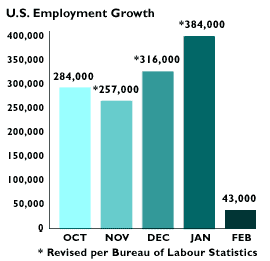|
4Q productivity jumps
|
 |
March 7, 2000: 8:49 a.m. ET
Worker productivity posts biggest gain in seven years; labor costs decline
By Staff Writer M. Corey Goldman
|
NEW YORK (CNNfn) - U.S. worker productivity surged in the fourth quarter and wage costs posted their biggest drop in nearly four years, according to revised figures released by the Labor Department Tuesday, capping a decade during which work force efficiency helped propel the U.S. economy toward its longest uninterrupted expansion ever.
Productivity, a measure of output, jumped 6.4 percent in the fourth quarter, in line with the 6.3 percent increase anticipated by analysts polled by Reuters and above the 5 percent gain initially reported a month ago. Labor costs -- a measure of what companies spend on worker output -- fell 2.5 percent in the October to December period, greater than the 2.2 percent decline expected and the 1 percent drop initially reported.
While the numbers were a pleasant reminder to Wall Street of how massive strides in technology have boosted productivity and kept costs down for companies, they failed to change anyone's opinion that the Federal Reserve will continue its mission of reigning in the U.S. economy with further interest rate increases, a mission meant to keep inflation from accelerating.
"With the fastest productivity growth and biggest drop in unit labor costs in seven years, the numbers are certainly worth shouting about, but as yet we are far from convinced that much of the improvement is structural," said Ian Shepherdson, chief U.S. economist with High Frequency Economics. "Mr. Greenspan is of the same view, which is why rates are going up no matter what happens to productivity growth."
Productive U.S. workers
The productivity gain was the biggest since a 7.4 percent jump in the fourth quarter of 1992, while the decline in unit labor costs was the largest since a 1.4 percent drop in the first quarter of 1996. For the year, productivity gained a revised 3 percent, up from 2.9 percent initially estimated last month and above 1998's 2.8 percent. Labor costs rose 1.7 percent, down from the 1.8 percent reading initially reported and a 2.4 percent increase a year earlier.
 Fueling the U.S. economy's blazing performance in recent years has been incredible advances in technology -- everything from smaller and faster computer chips to wireless telephones to new and innovative ways to move information quickly from one end of the world to the other. The U.S. economy expanded at a 6.9 percent pace in the fourth quarter. Fueling the U.S. economy's blazing performance in recent years has been incredible advances in technology -- everything from smaller and faster computer chips to wireless telephones to new and innovative ways to move information quickly from one end of the world to the other. The U.S. economy expanded at a 6.9 percent pace in the fourth quarter.
While those kinds of products and services have fueled productivity and allowed the economy to grow at an impressive, non-inflationary pace, the productivity gains are fueling expectations for corporate profits, a theme that has spurred the Nasdaq to multiple records and spawned a giddy glee on Wall Street and Main Street that has encouraged consumers to spend.
Greenspan alluded to that phenomenon Monday, suggesting that the Fed will have to remain "vigilant" to ensure that the benefits of productivity do not harm the economy by producing more demand for goods and services than supply. That is precisely why most analysts expect the Fed will lift its benchmark interest rate for the fifth time since last June when its policy setting arm, the Federal Open Market Committee, meets in Washington in two weeks.
More rate increases
Jeoff Hall, a senior economist with Thompson Global Markets in Boston, told CNNfn's Before Hours that he expects the first quarter to produce similarly strong growth and productivity numbers, which probably will lead to more rate increases by the Fed through the summer. (300KB WAV) (300KB AIFF)
 The reasoning behind that, according to Hall and other economists, is the pace of the U.S. economy -- now in its ninth and record year of uninterrupted expansion. On the one hand, the economy is growing at a much faster speed than is considered "comfortable" by most economists. On the other, gains in productivity have made that pace of growth more acceptable. The reasoning behind that, according to Hall and other economists, is the pace of the U.S. economy -- now in its ninth and record year of uninterrupted expansion. On the one hand, the economy is growing at a much faster speed than is considered "comfortable" by most economists. On the other, gains in productivity have made that pace of growth more acceptable.
And since companies are able to get more output from their workers while keeping costs in line, they are not being forced to pass on higher costs to consumers in the form of price increases. That means the white-hot U.S. labor market is not posing a threat to the economic expansion either.
What are companies doing?
Advanced Micro Devices (AMD: Research, Estimates) on Monday rolled out its new 1-gigabyte microprocessor chip, the fastest processor currently available on the commercial market. With high-speed Internet access all the rage and Internet-capable "smart" appliances on the way, analysts anticipate demand for faster and smaller chips will grow.
International Business Machines (IBM: Research, Estimates) is another example. The world's biggest computer maker last month unveiled a super computer chip that runs five times as fast as its competitors' products. The company is also working on a new supercomputer code-named "Blue Gene."
Even e-commerce companies are getting faster and more efficient at taking orders and the goods out to consumers -- without passing costs on to consumers. Amazon.com (AMZN: Research, Estimates), the world's biggest online retailer, last month posted a fourth-quarter loss, though it assured investors that it is working at boosting its productivity and profitability.
 All that is happening at a time when the economy is beginning to exhibit some faint - albeit very faint -- signs of slowing, at least on the consumer side, which accounts for about two-thirds of economic output. On Friday, the Labor Department reported that the economy generated significantly fewer jobs than expected last month, while wages remained steady and the jobless rate rose. All that is happening at a time when the economy is beginning to exhibit some faint - albeit very faint -- signs of slowing, at least on the consumer side, which accounts for about two-thirds of economic output. On Friday, the Labor Department reported that the economy generated significantly fewer jobs than expected last month, while wages remained steady and the jobless rate rose.
"This is almost the best of all possible worlds, where labor is making money, and yet corporations have been able to offset that with productivity, and keep it themselves in terms of profits," said Brian Fabbri, chief economist with New York-based Paribas. "It reminds everyone of the important contributions technology has been making to increased productivity in tight labor markets."
Signs of fatigue?
Other numbers showing stable prices, declining durable goods orders, falling home sales and faltering consumer confidence have also suggested that some areas of the economy are starting to show signs of fatigue, even as the economy streaks along.
Today's numbers lay further credence to the New Paradigm theory that a growing number of economists and investors have been wary to accept -- that the U.S. economy is being spurred by strong productivity gains that are making companies and workers more efficient.
Greenspan has been one of many advocates of that theory, suggesting in speeches and testimony in recent months that productivity gains have pushed the U.S. economy into an era of growth without inflation, similar in nature to the Industrial Revolution of the 1800s.
At the same time, the Fed chief, along with many other market watchers, has been loath to reject the old-school/old-economy notion that prices eventually will rise. That is why he and his colleagues raised rates again last month -- the fourth quarter-point move since last June -- and are expected to move rates by another quarter point at their March 21 meeting.
Either way, there is little question that productivity is significantly higher. After resting around the 1 percent level in the 1970s and 1980s, U.S. productivity growth remained above 2 percent throughout most of 1990s. 
|
|
|
|
|
 |

|

